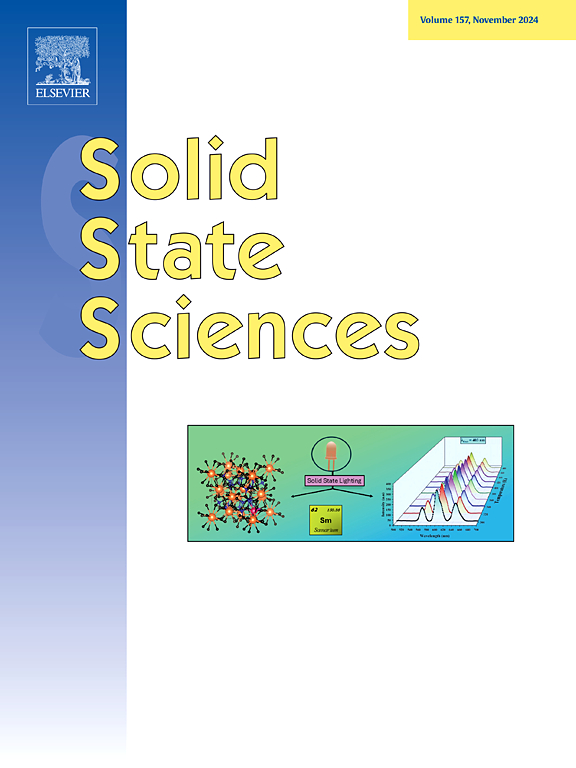Effective degradation of tetracycline by visible light-assisted activation of persulfate (PDS) by the magnetic material MnFe2O4/BC/P-CN
IF 3.3
3区 化学
Q2 CHEMISTRY, INORGANIC & NUCLEAR
引用次数: 0
Abstract
Large amounts of antibiotic residues cause serious damage to the ecological environment and water resources. Traditional treatment techniques have limited ability to remove them. In this paper, the magnetic material MnFe2O4/BC/P-CN was successfully prepared using a simple combination of roasting and impregnation strategy. Photofenton degradation of antibiotic pollutant tetracycline was carried out under visible light irradiation using peroxosulfate (K2S2O8) as an oxidizing agent, and the degradation rate reached 99.7 % within 70 min. This was attributed to the synergistic promotional effect between P-CN/BC and MnFe2O4, including good adsorption, enhanced light absorption, and high charge carrier mobility. EPR assay showed that the main active substances included •O2−, 1O2, •SO4− and •OH, which was derived from S2O82−, which promoted the self-oxidizing reduction of iron and manganese atoms. The materials were found to be structurally stable with excellent performance through multiple recycling. This ternary photocatalyst, composed of three semiconductors with excellent band gaps, is expected to achieve efficient absorption of sunlight. We characterized the P-CN/BC/MnFe2O4 photocatalyst through various analytical techniques and investigated its performance in degrading TC under visible light. Additionally, we used methods such as radical detection and intermediate product identification to thoroughly elucidate the mechanism of persulfate activation by photocatalysis and the degradation pathway of tetracycline.

磁性材料MnFe2O4/BC/P-CN可见光辅助活化过硫酸盐(PDS)降解四环素的研究
大量抗生素残留对生态环境和水资源造成严重破坏。传统的治疗技术去除它们的能力有限。本文采用简单的焙烧和浸渍相结合的方法成功制备了磁性材料MnFe2O4/BC/P-CN。以过硫酸盐(K2S2O8)为氧化剂,在可见光照射下对抗生素污染物四环素进行光fenton降解,在70 min内降解率达到99.7%。这是由于P-CN/BC与MnFe2O4之间具有良好的吸附、增强的光吸收和高载流子迁移率等协同促进作用。EPR分析表明,主要活性物质为•O2−、1O2、•SO4−和•OH,这些活性物质来源于S2O82−,促进了铁和锰原子的自氧化还原。经多次循环利用,发现该材料结构稳定,性能优良。这种三元光催化剂由三种具有优异带隙的半导体组成,有望实现对阳光的有效吸收。通过各种分析技术对P-CN/BC/MnFe2O4光催化剂进行了表征,并研究了其在可见光下降解TC的性能。此外,我们还利用自由基检测和中间产物鉴定等方法,深入阐明了过硫酸盐光催化活化的机理和四环素的降解途径。
本文章由计算机程序翻译,如有差异,请以英文原文为准。
求助全文
约1分钟内获得全文
求助全文
来源期刊

Solid State Sciences
化学-无机化学与核化学
CiteScore
6.60
自引率
2.90%
发文量
214
审稿时长
27 days
期刊介绍:
Solid State Sciences is the journal for researchers from the broad solid state chemistry and physics community. It publishes key articles on all aspects of solid state synthesis, structure-property relationships, theory and functionalities, in relation with experiments.
Key topics for stand-alone papers and special issues:
-Novel ways of synthesis, inorganic functional materials, including porous and glassy materials, hybrid organic-inorganic compounds and nanomaterials
-Physical properties, emphasizing but not limited to the electrical, magnetical and optical features
-Materials related to information technology and energy and environmental sciences.
The journal publishes feature articles from experts in the field upon invitation.
Solid State Sciences - your gateway to energy-related materials.
 求助内容:
求助内容: 应助结果提醒方式:
应助结果提醒方式:


